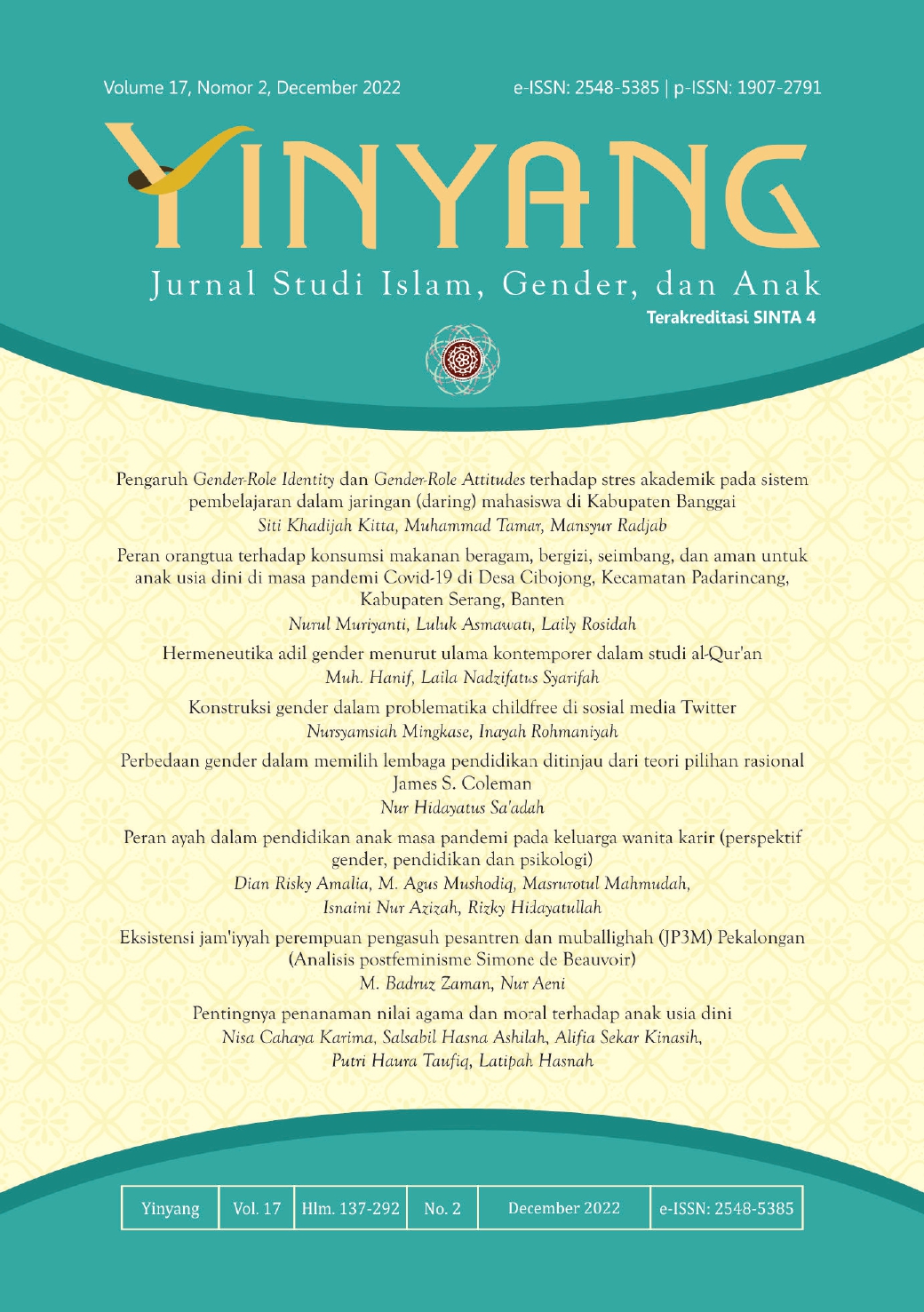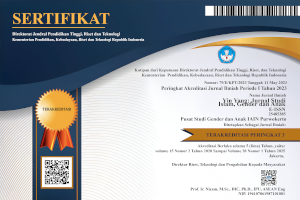Konstruksi gender dalam problematika childfree di sosial media Twitter
DOI:
https://doi.org/10.24090/yinyang.v17i2.6486Keywords:
Childfree, Gender Contruction, TwitterAbstract
Women's roles and feminine identities have historically and traditionally been built around motherhood. However, in recent years there has been a growing trend of childfree (without children) educating people about not parenting as a legitimate life choice through qualitative methods with virtual ethnographic studies. Analyzing Twitter tweets using the social construction theory of Peter L. Berger and Thomas Luckmann through a gender perspective, this paper aims to review gender construction in childfree problems where this choice is still considered taboo in the public sphere. Being Childfree allows having a positive identity oneself as an autonomous, rational, and responsible decision-maker. At the same time, rejecting that choice allows someone who cannot choose child-free (for various reasons) to have a flawless identity regarding deviations from the norm of parenthood. Although childfree is still only known in Indonesia as a whole or a broader context, childfree has been practiced by several people in a private space. However, this choice is against the culture of society where the family is considered an essential component in the life cycle; many do not feel the need or do not dare to speak up. Not only non-natural differences, gender construction that places women's nature at the biological level is also problematic. The nature of women who have a uterus is required to function correctly so that child-free decisions are considered deviant and abnormal.Downloads
References
Abdullah, I. (2012). Penelitian Berwawasan Gender dalam Ilmu Sosial. Humaniora, 15(3), 265–275. https://doi.org/10.22146/jh.v15i3.794
Asmaret, D. (2018). Kajian Tentang Gender Perspektif Islam (Studi Analisis Tentang Posisi Perempuan dan Laki-laki dalam Islam). JURIS (Jurnal Ilmiah Syariah), 17(2), 259. https://doi.org/10.31958/juris.v17i2.1164
Astuti, D. (2020). Melihat Konstruksi Gender Dalam Proses Modernisasi Di Yogyakarta. POPULIKA, 8(1). https://doi.org/10.37631/populika.v8i1.131
Bhambhani, C., & Inbanathan, A. (2020). Examining a non-conformist choice: The decision-making process toward being childfree couples. International Journal of Sociology, 50(5). https://doi.org/10.1080/00207659.2020.1797265
Blackstone, A. (2019). Childfree by choice the movement redefining family and creating a new age of independence by Dr. Amy Blackstone (z-lib.org).epub.
Bourdieu, P. (2011). Dominasi Maskulin (La Mascule Domination). Jalasutera.
Boyd, D., Golder, S., & Lotan, G. (2010). Tweet, tweet, retweet: Conversational aspects of retweeting on twitter. Proceedings of the Annual Hawaii International Conference on System Sciences. https://doi.org/10.1109/HICSS.2010.412
Bungin, B. (2008). Konstruksi Sosial Media Massa. Kencana.
Chrastil, R. (2019). How to Be Childless. In How to Be Childless. https://doi.org/10.1093/oso/9780190918620.001.0001
Corbett, L. (2018). Other than Mother: The Impact of Voluntary Childlessness on Meaning in Life, and the Potential for Positive Childfree Living. International Journal of Existential Psychology and Psychotherapy, 7(2).
Defago, N. (2005). Childfree and Loving It! In usion Press, a division of Satin Publications Ltd.
DeLyser, G. (2012). At Midlife, Intentionally Childfree Women and Their Experiences of Regret. Clinical Social Work Journal, 40(1). https://doi.org/10.1007/s10615-011-0337-2
Elaine Showalter (ed). (1989). Speaking of Gender. Routledge.
Fakih, M. (2008). Mansour Fakih.
Gillespie, R. (2003). Childfree and feminine: Understanding the gender identity of voluntarily childless women. Gender and Society, 17(1). https://doi.org/10.1177/0891243202238982
Haffner, M. (2020). Twitter. In Geographies of the Internet. https://doi.org/10.4324/9780367817534-20
Ilina, I. M., Osipova, N. V., Mazhuga, E. Y., Terenichenko, A. A., Losyakov, A. V., Antonova, N. V., & Melgunov, V. D. (2019). Voluntary childlessness as phenomenon of human ecology: Is it social responsibility or personal interest? EurAsian Journal of BioSciences, 13(2).
Iverson, H., Lindsay, B., & MacInnis, C. C. (2020). You don’t want kids?!: Exploring evaluations of those without children. Journal of Social Psychology, 160(5). https://doi.org/10.1080/00224545.2020.1742080
Karimulloh, K., Listiyandini, R. A., & Kusristanti, C. (2020). Program Penyuluhan Pra Nikah untuk Meningkatkan Pengetahuan mengenai Pernikahan Islami. Aksiologiya: Jurnal Pengabdian Kepada Masyarakat, 4(2). https://doi.org/10.30651/aks.v4i2.2893
Kokott, K., Lengersdorf, D., & Schlüter, K. (2018). Gender construction in experiment-based biology lessons. Education Sciences, 8(3). https://doi.org/10.3390/educsci8030115
Kwak, H., Lee, C., Park, H., & Moon, S. (2010). What is Twitter, a social network or a news media? Proceedings of the 19th International Conference on World Wide Web, WWW ’10. https://doi.org/10.1145/1772690.1772751
Laksono, P. (2017). Konstruksi Gender Di Pesantren (Studi Kualitatif Pada Santriwati Di Pesantren Nurul Ummah Mojokerto). Lakon : Jurnal Kajian Sastra Dan Budaya, 6(1). https://doi.org/10.20473/lakon.v6i1.6791
Lestari, D., & Wirdanengsih, W. (2020). stereotipe terhadap perempuan penyandang disabilitas di kota Padang ( studi pada perempuan penyandang disabilitas daksa di DPC PPDI kota Padang). Jurnal Perspektif, 3(2). https://doi.org/10.24036/perspektif.v3i2.249
Letherby, G. (2002). Childless and bereft?: Stereotypes and realities in relation to “voluntary” and “involuntary” childlessness and womanhood. Sociological Inquiry, 72(1). https://doi.org/10.1111/1475-682X.00003
Liu, B. (2012). Sentiment analysis and opinion mining. Synthesis Lectures on Human Language Technologies, 5(1). https://doi.org/10.2200/S00416ED1V01Y201204HLT016
Maie, C. (2007). No Kids: 40 Reasons For Not Having Children.
Mangande, J., & Lahade, J. (2021). Kualitas pernikahan dan status kesehatan mental pada perempuan yang menikah usia dini 1. Jurnal Keperawatan Jiwa (JKJ): Persatuan Perawat Nasional Indonesia, 9(2).
Morison, T., Macleod, C., Lynch, I., Mijas, M., & Shivakumar, S. T. (2016). Stigma Resistance in Online Childfree Communities: The Limitations of Choice Rhetoric. Psychology of Women Quarterly, 40(2). https://doi.org/10.1177/0361684315603657
Murthy, D. (2017). Twitter. In Polity Press.
Nasrullah, R. (2014). Teori dan Riset Media Siber (Cybermedia): Edisi Pertama. Jakarta: Kencana Media Group.
Nugraha, A., Sudrajat, R. H., & Putri, B. P. S. (2015). Fenomena Meme Di Media Sosial: Studi Etnografi Virtual Posting Meme Pada Pengguna Media Sosial Instagram. Jurnal Sosioteknologi, 17(101).
Nursyamsiah. (2018). Relasi Gender dan Kekuasaan. Alauddin University Press.
Pak, A., & Paroubek, P. (2010). Twitter as a corpus for sentiment analysis and opinion mining. Proceedings of the 7th International Conference on Language Resources and Evaluation, LREC 2010. https://doi.org/10.17148/ijarcce.2016.51274
Permana, M. Z., & Medynna, A. D. N. (2021). Ribet!: Persepsi Menikah pada Emerging Adulthood. Psikostudia : Jurnal Psikologi, 10(3). https://doi.org/10.30872/psikostudia.v10i3.5509
Peter L. Berger dan Thomas Luckmann. (1990). Tafsir Sosial Atas Kenyataan, Risalah tentang Sosiologi Pengetahuan. LP3ES.
Pratiwi, M., Yusanto, Y., & Nurjuman, H. (2021). Konstruksi Maskulinitas Perempuan Melawan Tindak Kekerasan pada Film Thriller: (Analisis Semiotika pada Film Marlina Si Pembunuh dalam Empat Babak). KOMUNIKA, 8(2). https://doi.org/10.22236/komunika.v8i1.5670
Puspitawati, H. (2012). Konsep, Teori Dan Analisis Gender. In Gender dan Keluarga: Konsep dan Realita di Indonesia.
Rohmaniyah, I. (2009). Gender Dan Konstruksi. Jurnal Studi Ilmu-Ilmu Al-Quran Dan Hadits, 10(2), 207–230.
Rohmaniyah, I. (2013). Gender Androsentrisme Dan Sexisme Dalam Tafsir Agama. WELFARE, 2(1), 55–74.
Rosyidah, F. N., & Nurwati, N. (2019). Gender dan Stereotipe: Konstruksi Realitas dalam Media Sosial Instagram. Share : Social Work Journal, 9(1). https://doi.org/10.24198/share.v9i1.19691
Sari, N. L. K. R., & Widiasavitri, P. N. (2018). Gambaran Kesejahteraan Subjektif Pada Wanita Yang Mengalami Involuntary Childlessness. Jurnal Psikologi Udayana, 4(02). https://doi.org/10.24843/jpu.2017.v04.i02.p11
Scarborough, W. J. (2018). Feminist Twitter and Gender Attitudes: Opportunities and Limitations to Using Twitter in the Study of Public Opinion. Socius: Sociological Research for a Dynamic World, 4. https://doi.org/10.1177/2378023118780760
Sedarmayanti, S. H. dan. (2011). Metodologi Penelitian. Mandar Maju.
Stahnke, B., Blackstone, A., & Howard, H. (2020). Lived Experiences and Life Satisfaction of ChildFree Women in Late Life. Family Journal, 28(2). https://doi.org/10.1177/1066480720911611
Sulistyawan, A. Y., & Nurfaidah, S. S. (2020). Gender Construction in Islamic Perspective. Ijtimā’iyya: Journal of Muslim Society Research, 5(1). https://doi.org/10.24090/ijtimaiyya.v5i1.4000
Tiwari, S., Kumar, S., Jethwani, V., Kumar, D., & Dadhich, V. (2022). PNTRS: Personalized news and tweet recommendation system. Journal of Cases on Information Technology, 24(3). https://doi.org/10.4018/JCIT.20220701.oa9
Toifah, N. (2020). Konsepsi Ilmu Kedokteran Modern Tentang Larangan Incest Dalam Surat An-Nisa’:23. Journal of Islamic Medicine, 4(1). https://doi.org/10.18860/jim.v4i1.8187
Ulfa, M. (2021). Mengkaji Pilihan Childfree. Institut Agama Islam Negeri Jember Lembaga Penjamin Mutu.
Victoria Tunggono. (2021). Childfree and Happy. Buku Mojok Group.
Volsche, S. L. (2018). Setting the childless free: An ethnographic study of the practice of the childfree identity. In Dissertation Abstracts International Section A: Humanities and Social Sciences (Vol. 79, Issues 8-A(E)).
Warsito, W. (2018). Hadist Perintah Memperbanyak Keturunan Tinjuan Textual dan Kontekstual dalam Prespektif Ekonomi. Riwayah : Jurnal Studi Hadis, 4(1). https://doi.org/10.21043/riwayah.v4i1.3118
Waterloo, S. F., Baumgartner, S. E., Peter, J., & Valkenburg, P. M. (2018). Norms of online expressions of emotion: Comparing Facebook, Twitter, Instagram, and WhatsApp. New Media and Society, 20(5). https://doi.org/10.1177/1461444817707349
Weng, J., Lim, E. P., Jiang, J., & He, Q. (2010). TwitterRank: Finding topic-sensitive influential twitterers. WSDM 2010 - Proceedings of the 3rd ACM International Conference on Web Search and Data Mining. https://doi.org/10.1145/1718487.1718520
Zhang, Z. (2019). From media hype to twitter storm: news explosions and their impact on issues, crises and public opinion. In Critical Studies in Media Communication (Vol. 36, Issue 4). https://doi.org/10.1080/15295036.2019.1593479
Downloads
Published
How to Cite
Issue
Section
License
Copyright (c) 2022 Nursyamsiah Mingkase, Inayah Rohmaniyah

This work is licensed under a Creative Commons Attribution-ShareAlike 4.0 International License.
Authors who publish with this journal agree to the following terms: Authors retain copyright and grant the journal right of first publication with the work simultaneously licensed under a Creative Commons Attribution-ShareAlike 4.0 International License that allows others to share the work with an acknowledgment of the work's authorship and initial publication in this journal.


















